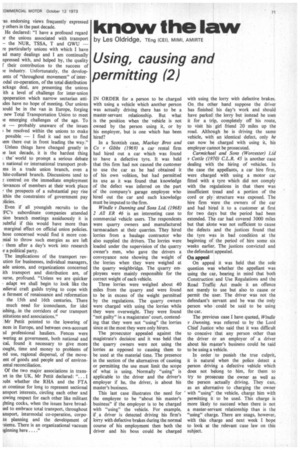know the law
Page 69

If you've noticed an error in this article please click here to report it so we can fix it.
by Les Oldridge, TEng (CEO, MIMI, AMIRTE
Using, causing and permitting (2)
IN ORDER for a person to be charged with using a vehicle which another person was actually driving there has to be a master-servant relationship. But what is the position when the vehicle is not owned by the person using it, or by his employer, but is one which has been hired?
In a Scottish case, Mackay Bros and Co v Gibbs (1969) a car rental firm had hired out a car which was found to have a defective tyre. It was held that this firm had not caused the customer to use the car as he had obtained it of his own volition, but had permitted its use as it was found that knowledge of the defect was inferred on the part of the company's garage employee who hired out the car and such knowledge must be imputed to the firm.
Windle v Dunning and Sons Ltd (1968) 2 All ER 46 is an interesting case to commercial vehicle users. The respondents were quarry owners and manufactured tarmacadam at their quarries. They hired lorries from a haulage contractor who also supplied the drifters. The lorries were loaded under the supervision of the quarry owner's men, who gave the drivers a conveyance note showing the weight of the lorries when they were weighed at the quarry weighbridge. The quarry employees were mainly responsible for the correct weight of each vehicle.
Three lorries were weighed about 40 miles from the quarry and were found to be in excess of the weight permitted by the regulations. The quarry owners were charged with using the lorries while they were overweight. They were found "not guilty" in a magistrates' court, contending that they were not "using" the lorries since at the most they were only hirers.
The prosecutor appealed against the magistrate's decision and it was held that the quarry owners were not using the lorries as opposed to causing them to be used at the material time. The presence in the section of the alternatives of causing or permitting the use must limit the scope of what is using. Normally "using" is applicable to the driver and the driver's employer if he, the driver, is about his master's business.
This last case illustrates the need for the employee to be "about his master's business" if the employer is to be charged with "using" the vehicle. For example, if a driver is detected driving his firm's lorry with defective brakes during the normal course of his employment then both the driver and his boss could be charged
with using the lorry with defective brakes. On the other hand suppose the driver has finished his day's work and should have parked the lorry but instead he uses it for a trip, completely off his route, to visit his girl friend 20 miles up the road. Although he is driving the same vehicle, with an identical defect, only he can now be charged with using it, his employer cannot be prosecuted. Carmichael and Sons (Worcester) Ltd v Cottle (1970) CL.R. 45 is another case dealing with the hiring of vehicles. In the case the appellants, a car hire firm, were charged with using a motor car fitted with a tyre which did not comply with the regulations in that there was insufficient tread and a portion of the cord or ply structure was exposed. The hire firm were •the owners of the car and had hired it to a customer at first for two days but the period had been extended. The car had covered 3000 miles but that alone was not sufficient to cause the defects and the justices found that the tyre was in bad condition at the beginning of the period of hire some six weeks earlier. The justices convicted and the defendant appealed.
On appeal
On appeal it was held that the sole question was whether the appellant was using the car, bearing in mind that both Construction and Use Regulations and the Road Traffic Act made it an offence not merely to use but also to cause or permit the user. The driver was not the defendant's servant and he was the only person who could be said to be using the car.
The previous case I have quoted, Windle v Dunning, was referred to by the Lord Chief Justice who said that it was difficult to conceive that any person other than the driver or an employer of a driver about his master's business could be said to be using a vehicle.
In order to punish the true culprit, it is natural when the police detect a person driving a defective vehicle which does not belong to him, for them to try to prosecute the owner as well as the person actually driving. They can, as an alternative to charging the owner ' with "using" the vehicle, charge him with permitting it to be used. This charge is more likely to succeed when there is not a master-servant relationship than is the "using" charge. There are snags, however, with this charge and next week I hope to look at the relevant case law on this subject.




















































































































